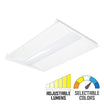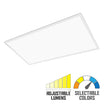Lighting plays a crucial role in the aesthetics, ambiance, functionality, and overall mood of our homes. The magic of effective lighting lies in its ability to transform a room, enhance architectural features, establish focal points, and create the desired mood. In this comprehensive guide, we'll delve into the art and science of lighting, focusing on how to choose and position different light fixtures to create a harmonious and inviting home environment.
Understanding the Layers of Light
Every home needs a blend of different types of light to achieve a balanced and functional lighting scheme. These are typically categorized into three layers: ambient, task, and accent lighting.
Ambient Lighting
Also known as general lighting, ambient lighting is the primary source of light in a room, providing overall illumination. This type of lighting ensures that the room is evenly lit, eliminating dark corners and shadows. Ambient lighting is typically achieved through overhead fixtures such as ceiling lights, chandeliers, or wall sconces.
Task Lighting
Task lighting focuses on specific areas to facilitate activities that require precision and clarity, such as reading, cooking, or working. It enhances visibility and reduces eye strain in work areas. Common task lighting fixtures include desk lamps, under-cabinet lights, pendant lights, and wall-mounted fixtures.
Accent Lighting
Accent lighting creates visual interest by highlighting specific objects, architectural features, or areas within a room. This type of lighting is often used to draw attention to art pieces, textured wallpapers, or unique architectural elements, adding depth and drama to the room's overall design.
The Role of Natural Lighting
Natural lighting significantly influences our perception of space and color. It not only enhances the aesthetics of a room but also contributes to our sense of well-being and stress reduction. Incorporating natural light into your home's lighting design can result in a more inviting and comfortable living environment.
How to Choose Light Fixtures for Your Home
When selecting light fixtures for your home, it's essential to consider the room's purpose, the desired mood, and the existing decor. Here are some key factors to keep in mind:
Define Each Room’s Purpose
The function of the room is a critical factor in selecting light fixtures. Different activities require specific types of lighting to create a comfortable and functional environment. For instance, a kitchen benefits from bright task lighting for food preparation, while a bedroom needs soft, ambient lighting to promote relaxation.
Consider the Room's Dimensions
The size and layout of the room can influence the type of fixtures you choose. High ceilings may require pendant lights or chandeliers, while low ceilings may benefit from flush-mount or semi-flush-mount fixtures. Additionally, the height of your furniture can also affect the placement of your light fixtures.
Think About Color Temperature
Color temperature can significantly impact the room's atmosphere. Warm color temperatures create a cozy and relaxed ambiance, making them suitable for living rooms and bedrooms. In contrast, cooler color temperatures provide a bright, energizing feel, suitable for task-oriented spaces like kitchens or home offices.
Install Dimmers
Dimmers offer flexibility and control over the lighting conditions in your room. They allow you to adjust the light levels to suit different tasks, moods, and times of day. Dimmers also contribute to energy efficiency by reducing electricity consumption when full brightness is not required.
Effective Placement of Light Fixtures
The placement of light fixtures is just as important as their selection. Here are some tips on how to position different types of light fixtures for optimal illumination and aesthetic appeal.
Entryways
The entryway is an ideal place to make a grand statement with a chandelier. Ensure the bottom of the chandelier is between 80"-84" from the floor to maintain a balanced look.
Living Rooms
For living rooms, a combination of ambient, accent, and task lighting works best. Consider installing track lighting to highlight artwork and architectural details. Ensure the lighting fixtures are positioned at a height that provides even illumination without obstructing sightlines or creating glare.
Kitchens
In the kitchen, balance the lighting with multiple light sources to minimize shadows and glare. Overhead lighting can be complemented by under-cabinet lights to illuminate work surfaces. If you have a kitchen island, ensure the light fixtures are high enough to avoid direct glare.
Bedrooms
In the bedroom, opt for soft, ambient lighting to promote relaxation. Avoid installing lights directly above the bed to prevent glare. Consider adding bedside lamps for task lighting.
Bathrooms
Bathrooms require a blend of ambient and task lighting. Install overhead lights for general illumination and vanity lights around the mirror for focused task lighting. Ensure the lights are positioned at a height that provides adequate illumination without creating shadows.


















































Leave a comment
All comments are moderated before being published.
This site is protected by hCaptcha and the hCaptcha Privacy Policy and Terms of Service apply.